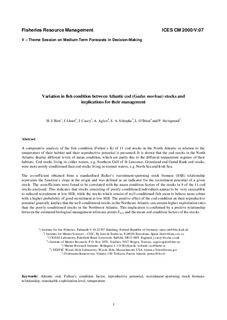Variation in fish condition between Atlantic cod (Gadus morhua) stocks and implications for their management
Rätz, Hans-Joachim; Lloret, J.; Casey, John; Aglen, Asgeir; Schopka, S.A.; O’Brien, Loretta; Steingrund, P.
Working paper

Åpne
Permanent lenke
http://hdl.handle.net/11250/100467Utgivelsesdato
2000Metadata
Vis full innførselSamlinger
Originalversjon
This report is not to be quoted without prior consultation with the General Secretary.Sammendrag
A comparative analysis of the fish condition (Fulton’s K) of 11 cod stocks in the North Atlantic in relation to the
temperature of their habitat and their reproductive potential is presented. It is shown that the cod stocks in the North
Atlantic display different levels of mean condition, which are partly due to the different temperature regimes of their
habitats. Cod stocks living in colder waters, e.g. Southern Gulf of St Lawrence, Greenland and Grand Bank cod stocks,
were more poorly-conditioned than cod stocks living in warmer waters, e.g. North Sea and Irish Sea.
The a-coefficient obtained from a standardised Ricker’s recruitment-spawning stock biomass (SSB) relationship
represents the function’s slope at the origin and was defined as an indicator for the recruitment potential of a given
stock. The a-coefficients were found to be correlated with the mean condition factors of the stocks in 9 of the 11 cod
stocks analysed. This indicates that stocks consisting of poorly-conditioned individuals appear to be very susceptible
to reduced recruitment at low SSB, while the stocks which consist of well conditioned fish seem to behave more robust
with a higher probability of good recruitment at low SSB. The positive effect of the cod condition on their reproductive
potential generally implies that the well-conditioned stocks in the Northeast Atlantic can sustain higher exploitation rates
than the poorly-conditioned stocks in the Northwest Atlantic. This implication is confirmed by a positive relationship
between the estimated biological management reference points Fmed and the mean cod condition factors of the stocks.
Utgiver
ICESSerie
ICES CM documents2000/V:07